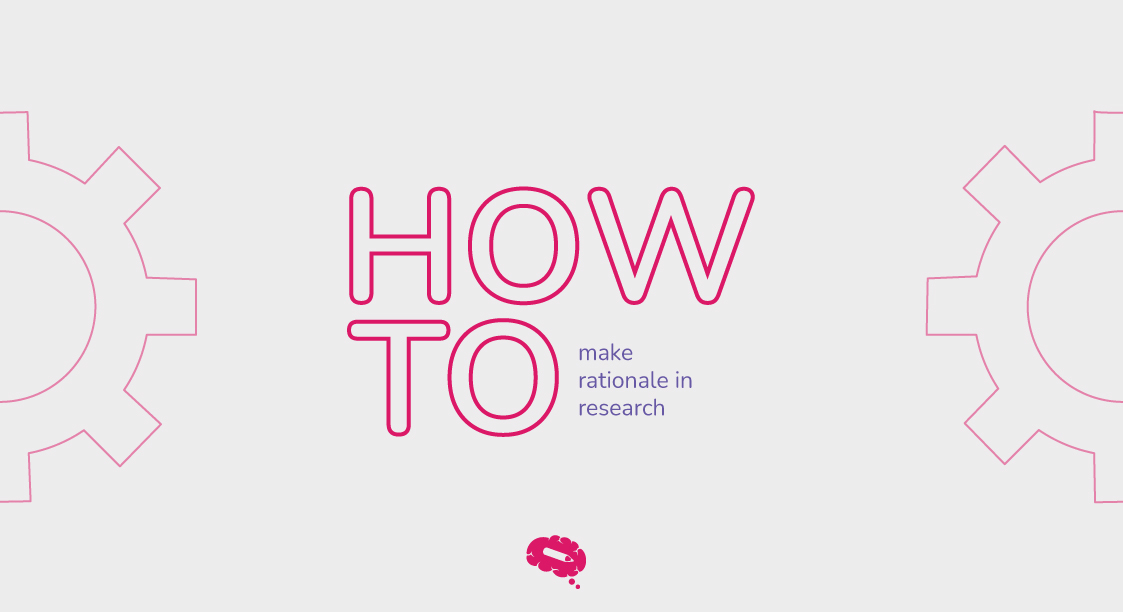Any academic or scientific discipline relies heavily on research. However, in order to do research properly, it is necessary to comprehend the rationale behind it. A research rationale is a succinct explanation of why a certain research project is required, describing the justifications for the study as well as the advantages it is expected to provide.
Writing a persuasive rationale is critical for obtaining approval for your research project and communicating the importance of your research. However, developing a convincing one can be difficult, especially for people new to research or unfamiliar with academic expectations.
After reading this thorough overview on “how to make rationale in research”, you will be better equipped to justify your research and communicate its significance to your academic community. Whether you are a student or a seasoned researcher, this article will provide valuable insights and strategies for creating a powerful research rationale.
Hva er en begrunnelse i forskning?
A research rationale provides an organized strategy for the whole research and acts as the cornerstone of the research project. It contributes to the research’s rationale by stating why the study is significant, what its aims are, and what the expected findings are. In essence, it is a compelling argument for why the study should be carried out.
En velskrevet forskningsbegrunnelse bør være kortfattet, presis og overbevisende. Den bør klargjøre problemet eller problemstillingen som studien forsøker å løse, kunnskaps- eller forståelsesgapet som studien søker å fylle, og de mulige fordelene den kan gi. I tillegg bør begrunnelsen vise at forskningen er mulig, etisk forsvarlig og relevant for emnet som skal studeres.
A research project that lacks a strong rationale may lack direction and may fail to address the stated problem or issue. It can also make obtaining financing or permission from institutional review boards (IRBs) or other governing bodies difficult. As a result, devoting effort to developing a compelling research rationale is critical to the success of any research.
Hvorfor er en forskningsbegrunnelse viktig?
En forskningsbegrunnelse er viktig av mange grunner. For det første bidrar den til å forklare nødvendigheten av forskningsprosjektet ved å vise hvorfor studien er nødvendig, og hvilke kunnskaps- eller forståelseshull den skal forsøke å fylle.
For det andre inneholder den en klar og kortfattet problemstilling som skisserer de nøyaktige forskningsspørsmålene eller målene som studien har til hensikt å besvare.
Finally, it aids in demonstrating the research’s potential influence by demonstrating how it may lead to the creation of new knowledge, practices, or policies.
To achieve this, you should focus on communicating the potential benefits of your project, while also acknowledging its limitations. This requires a thorough understanding of the research problem and a critical evaluation of the proposed methods and approaches.
Det er også viktig at du gir tilstrekkelig informasjon om metodene du planlegger å bruke, hvilke etiske hensyn du må ta, og hvordan du vil evaluere resultatene. Dette bidrar til å vise at du har en velutviklet og gjennomtenkt forskningsplan, noe som er viktig for å sikre finansiering eller få godkjenning fra akademiske institusjoner.
Ta et eksempel på et forskningsprosjekt for å demonstrere dette. Anta at du ønsker å undersøke hvor effektiv en ny undervisningsstil er når det gjelder å forbedre studentenes læringsresultater. En overbevisende begrunnelse for denne studien kan være følgende:
- Påvise behovet for studien: Du kan forklare at det er en økende bekymring i utdanningsmiljøet for lave elevprestasjoner, og at standard undervisningsmetoder kanskje ikke hjelper alle elever.
- Gi en tydelig problemstilling: Du kan for eksempel si at studien skal undersøke om den nye undervisningsmetoden er effektiv når det gjelder å forbedre studentenes læringsutbytte, og hvilke faktorer som kan påvirke effektiviteten.
- Highlighting the research’s potential impact: Du kan argumentere for at hvis studien viser at den nye undervisningsmetoden er effektiv, vil den bli tatt i bruk på andre skoler og øke elevenes læringsresultater.
Forskningsbegrunnelsen i dette eksemplet gir en klar og overbevisende forklaring på hvorfor det er nødvendig å gjennomføre studien, og understreker studiens relevans, problemstilling og mulige effekt.
En modell: Problem-Løsning-Begrunnelse
Problem-Løsning-Begrunnelse-modellen er et nyttig rammeverk for å utvikle en sterk forskningsbegrunnelse. Den kan hjelpe deg med å organisere begrunnelsen og sikre at den tydelig formidler all informasjon som kreves for en effektiv forskningsbegrunnelse. Modellen består av tre hovedkomponenter: identifisere problemet, foreslå en løsning og forklare hvorfor den foreslåtte løsningen er nødvendig.
Identifisering av problemet
The first stage in this model is to identify the problem that the study will attempt to solve. This could entail assessing existing research on the topic, finding gaps in knowledge or understanding, or emphasizing new difficulties or issues that have occurred. A clear problem statement serves as the research’s foundation, outlining the specific research questions or objectives that the study seeks to address.
Forslag til løsning
The model’s second stage is to suggest a solution to the identified problem. This might include creating a new theoretical framework, putting a new hypothesis to the test, or suggesting a new intervention or practice. The proposed solution should be based on a thorough review of the literature and a clear understanding of the research problem.
Gi en begrunnelse
The model’s final stage is to present a rationale for why the suggested solution is required. This might include emphasizing the possible advantages of the suggested solution, explaining how it builds on past research, or demonstrating how it fills a knowledge or understanding gap.
Språk til signalbegrunnelse
Effective communication is crucial when it comes to justifying the significance of your research. One of the ways you can achieve this is by using specific language that signals the rationale to your intended audience. By doing so, you can clearly convey the reasons for your study and its potential benefits to your audience. Here are a couple of such examples:
- “The goal of this research is to fill a knowledge gap on…”
- “We selected this methodology because it allows us to address the research question more effectively.”
- “Our approach is informed by the need to address the practical challenges of…”
- “This research is significant because it contributes to our understanding of…”
Slike utsagn kan hjelpe deg med å formidle begrunnelsen til publikum og understreke betydningen av forskningen din.
Language for Further Justification – Showing Importance
Once you’ve indicated the rationale for your research, it’s critical to give further justification that emphasizes the relevance of your study. Here are some sentences that might be used to emphasize the significance of your research:
- “By addressing this gap in knowledge, we can gain a better understanding of…”
- “This study is significant because it contributes to the development of…”
- “The implications of this research are far-reaching, and it can inform…”
- “By examining this issue, we can shed light on the broader implications of…”
Hvordan lage begrunnelser i forskning
Writing a compelling rationale for a research proposal is critical to obtaining funds and support for the research you are conducting. In this section, you will learn how to make rationale in research by implementing the four crucial aspects of a rationale: background on all previous research on the issue, the study’s open questions, identification of gaps in the literature, and the importance of filling these gaps.
Bakgrunn for all tidligere forskning:
You must clarify the existing level of knowledge of the topic to offer a clear grasp of your research proposal. This entails analyzing all past research on the subject and determining what has been done previously. It is critical to present a thorough summary of existing research, including major results, hypotheses, and methodology. This can assist in demonstrating that you have a deep awareness of the field’s present state of knowledge and how your planned study might contribute to it.
The Study’s Open Questions
The next stage is to identify the study’s open questions. This entails investigating areas where existing knowledge falls short and comprehension gaps exist. You may highlight the need for more research and explain how your research will address these gaps by identifying unanswered questions.
Mangler i litteraturen
Once you’ve discovered the open questions, describe how your research will solve them. This requires recognizing gaps in the current literature and describing how your research will address these gaps. Make it a point to explain how the proposed research differs from prior studies and how it will add to existing knowledge in the subject.
Viktigheten av å fylle disse hullene:
Til slutt er det viktig å vise hvor viktig det er å fylle disse hullene i litteraturen. Dette inkluderer å vise de mulige fordelene ved forskningen og skissere hvordan den vil hjelpe fagfeltet hvis den kan resultere i nye ideer eller nye tilnærminger, eller hvilken innvirkning den vil ha på det virkelige samfunnet.
Frigjør kraften i infografikk med Mind the Graph
Whether you’re a seasoned scientist or just starting out in your research career, Mind the Graph er et verdifullt, brukervennlig og intuitivt verktøy som kan bidra til å øke effekten av forskningen din ved å gjøre den mer engasjerende, tilgjengelig og forståelig for et bredere publikum.

Abonner på nyhetsbrevet vårt
Eksklusivt innhold av høy kvalitet om effektiv visuell
kommunikasjon innen vitenskap.






